Infant Brain Mri Segmentation
Papers and Code
Bilateral Hippocampi Segmentation in Low Field MRIs Using Mutual Feature Learning via Dual-Views
Oct 23, 2024



Accurate hippocampus segmentation in brain MRI is critical for studying cognitive and memory functions and diagnosing neurodevelopmental disorders. While high-field MRIs provide detailed imaging, low-field MRIs are more accessible and cost-effective, which eliminates the need for sedation in children, though they often suffer from lower image quality. In this paper, we present a novel deep-learning approach for the automatic segmentation of bilateral hippocampi in low-field MRIs. Extending recent advancements in infant brain segmentation to underserved communities through the use of low-field MRIs ensures broader access to essential diagnostic tools, thereby supporting better healthcare outcomes for all children. Inspired by our previous work, Co-BioNet, the proposed model employs a dual-view structure to enable mutual feature learning via high-frequency masking, enhancing segmentation accuracy by leveraging complementary information from different perspectives. Extensive experiments demonstrate that our method provides reliable segmentation outcomes for hippocampal analysis in low-resource settings. The code is publicly available at: https://github.com/himashi92/LoFiHippSeg.
Cas-DiffCom: Cascaded diffusion model for infant longitudinal super-resolution 3D medical image completion
Feb 21, 2024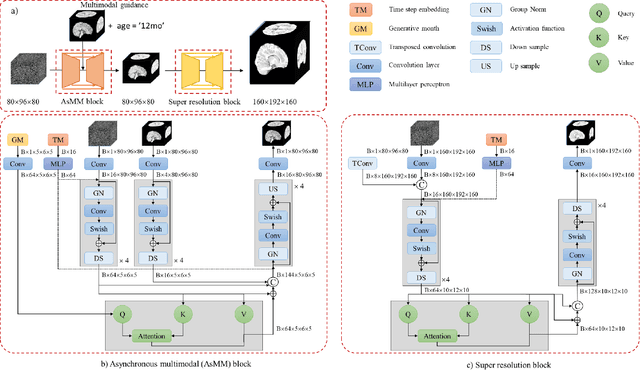

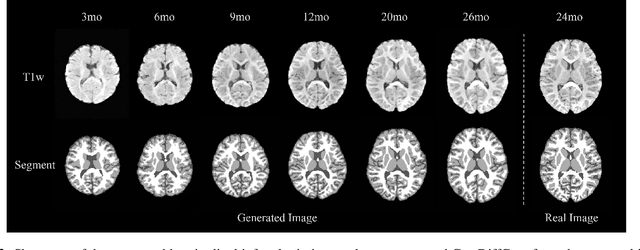

Early infancy is a rapid and dynamic neurodevelopmental period for behavior and neurocognition. Longitudinal magnetic resonance imaging (MRI) is an effective tool to investigate such a crucial stage by capturing the developmental trajectories of the brain structures. However, longitudinal MRI acquisition always meets a serious data-missing problem due to participant dropout and failed scans, making longitudinal infant brain atlas construction and developmental trajectory delineation quite challenging. Thanks to the development of an AI-based generative model, neuroimage completion has become a powerful technique to retain as much available data as possible. However, current image completion methods usually suffer from inconsistency within each individual subject in the time dimension, compromising the overall quality. To solve this problem, our paper proposed a two-stage cascaded diffusion model, Cas-DiffCom, for dense and longitudinal 3D infant brain MRI completion and super-resolution. We applied our proposed method to the Baby Connectome Project (BCP) dataset. The experiment results validate that Cas-DiffCom achieves both individual consistency and high fidelity in longitudinal infant brain image completion. We further applied the generated infant brain images to two downstream tasks, brain tissue segmentation and developmental trajectory delineation, to declare its task-oriented potential in the neuroscience field.
3D Masked Autoencoding and Pseudo-labeling for Domain Adaptive Segmentation of Heterogeneous Infant Brain MRI
Mar 16, 2023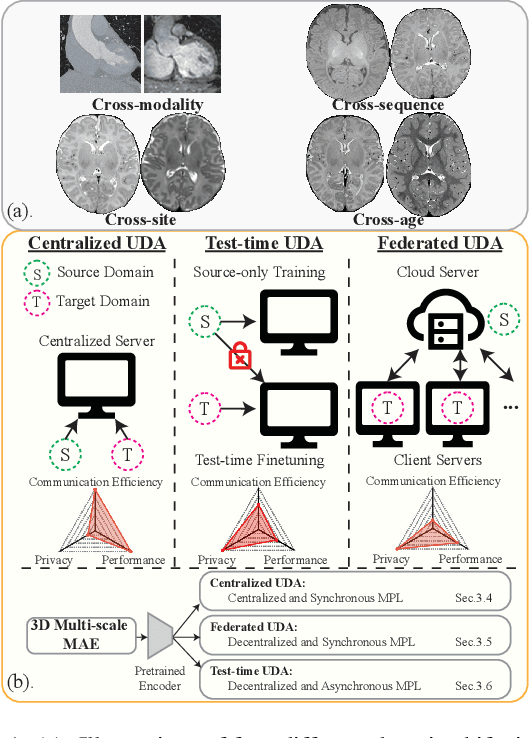
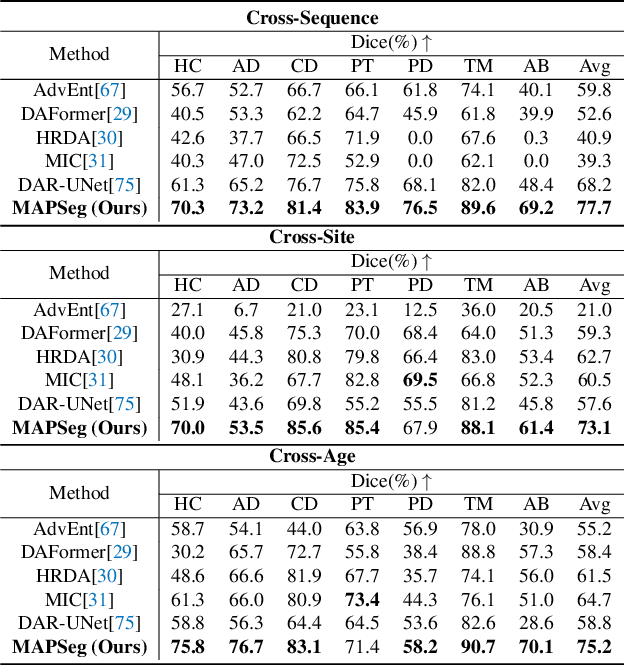


Robust segmentation of infant brain MRI across multiple ages, modalities, and sites remains challenging due to the intrinsic heterogeneity caused by different MRI scanners, vendors, or acquisition sequences, as well as varying stages of neurodevelopment. To address this challenge, previous studies have explored domain adaptation (DA) algorithms from various perspectives, including feature alignment, entropy minimization, contrast synthesis (style transfer), and pseudo-labeling. This paper introduces a novel framework called MAPSeg (Masked Autoencoding and Pseudo-labelling Segmentation) to address the challenges of cross-age, cross-modality, and cross-site segmentation of subcortical regions in infant brain MRI. Utilizing 3D masked autoencoding as well as masked pseudo-labeling, the model is able to jointly learn from labeled source domain data and unlabeled target domain data. We evaluated our framework on expert-annotated datasets acquired from different ages and sites. MAPSeg consistently outperformed other methods, including previous state-of-the-art supervised baselines, domain generalization, and domain adaptation frameworks in segmenting subcortical regions regardless of age, modality, or acquisition site. The code and pretrained encoder will be publicly available at https://github.com/XuzheZ/MAPSeg
Two Independent Teachers are Better Role Model
Jun 09, 2023Recent deep learning models have attracted substantial attention in infant brain analysis. These models have performed state-of-the-art performance, such as semi-supervised techniques (e.g., Temporal Ensembling, mean teacher). However, these models depend on an encoder-decoder structure with stacked local operators to gather long-range information, and the local operators limit the efficiency and effectiveness. Besides, the $MRI$ data contain different tissue properties ($TPs$) such as $T1$ and $T2$. One major limitation of these models is that they use both data as inputs to the segment process, i.e., the models are trained on the dataset once, and it requires much computational and memory requirements during inference. In this work, we address the above limitations by designing a new deep-learning model, called 3D-DenseUNet, which works as adaptable global aggregation blocks in down-sampling to solve the issue of spatial information loss. The self-attention module connects the down-sampling blocks to up-sampling blocks, and integrates the feature maps in three dimensions of spatial and channel, effectively improving the representation potential and discriminating ability of the model. Additionally, we propose a new method called Two Independent Teachers ($2IT$), that summarizes the model weights instead of label predictions. Each teacher model is trained on different types of brain data, $T1$ and $T2$, respectively. Then, a fuse model is added to improve test accuracy and enable training with fewer parameters and labels compared to the Temporal Ensembling method without modifying the network architecture. Empirical results demonstrate the effectiveness of the proposed method.
DAM-AL: Dilated Attention Mechanism with Attention Loss for 3D Infant Brain Image Segmentation
Dec 27, 2021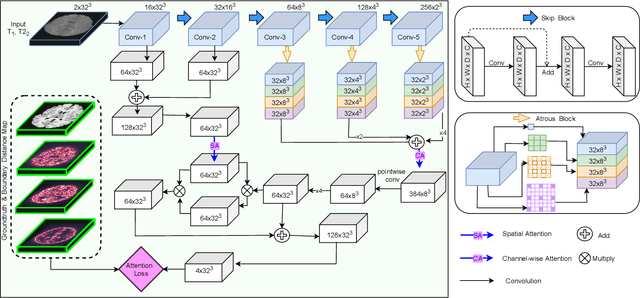


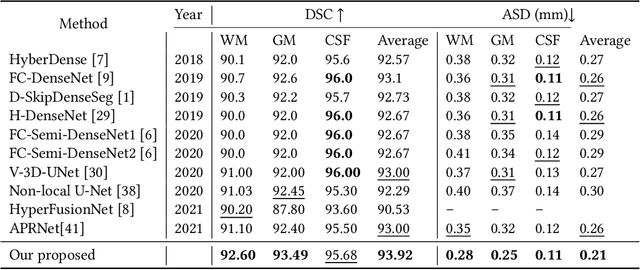
While Magnetic Resonance Imaging (MRI) has played an essential role in infant brain analysis, segmenting MRI into a number of tissues such as gray matter (GM), white matter (WM), and cerebrospinal fluid (CSF) is crucial and complex due to the extremely low intensity contrast between tissues at around 6-9 months of age as well as amplified noise, myelination, and incomplete volume. In this paper, we tackle those limitations by developing a new deep learning model, named DAM-AL, which contains two main contributions, i.e., dilated attention mechanism and hard-case attention loss. Our DAM-AL network is designed with skip block layers and atrous block convolution. It contains both channel-wise attention at high-level context features and spatial attention at low-level spatial structural features. Our attention loss consists of two terms corresponding to region information and hard samples attention. Our proposed DAM-AL has been evaluated on the infant brain iSeg 2017 dataset and the experiments have been conducted on both validation and testing sets. We have benchmarked DAM-AL on Dice coefficient and ASD metrics and compared it with state-of-the-art methods.
Local Spatiotemporal Representation Learning for Longitudinally-consistent Neuroimage Analysis
Jun 09, 2022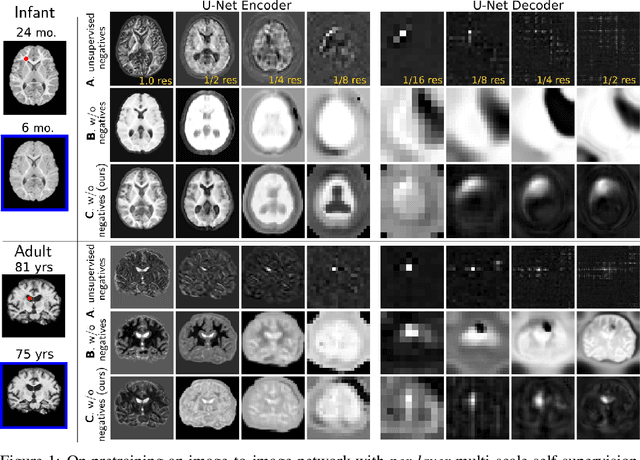


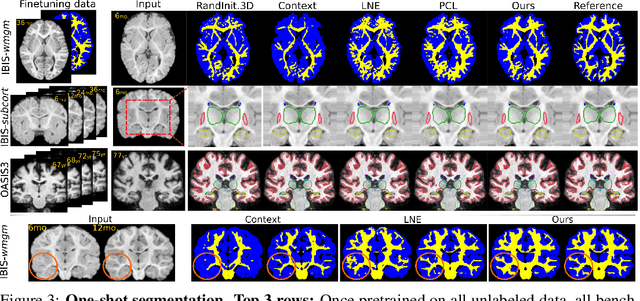
Recent self-supervised advances in medical computer vision exploit global and local anatomical self-similarity for pretraining prior to downstream tasks such as segmentation. However, current methods assume i.i.d. image acquisition, which is invalid in clinical study designs where follow-up longitudinal scans track subject-specific temporal changes. Further, existing self-supervised methods for medically-relevant image-to-image architectures exploit only spatial or temporal self-similarity and only do so via a loss applied at a single image-scale, with naive multi-scale spatiotemporal extensions collapsing to degenerate solutions. To these ends, this paper makes two contributions: (1) It presents a local and multi-scale spatiotemporal representation learning method for image-to-image architectures trained on longitudinal images. It exploits the spatiotemporal self-similarity of learned multi-scale intra-subject features for pretraining and develops several feature-wise regularizations that avoid collapsed identity representations; (2) During finetuning, it proposes a surprisingly simple self-supervised segmentation consistency regularization to exploit intra-subject correlation. Benchmarked in the one-shot segmentation setting, the proposed framework outperforms both well-tuned randomly-initialized baselines and current self-supervised techniques designed for both i.i.d. and longitudinal datasets. These improvements are demonstrated across both longitudinal neurodegenerative adult MRI and developing infant brain MRI and yield both higher performance and longitudinal consistency.
Infant brain MRI segmentation with dilated convolution pyramid downsampling and self-attention
Dec 29, 2019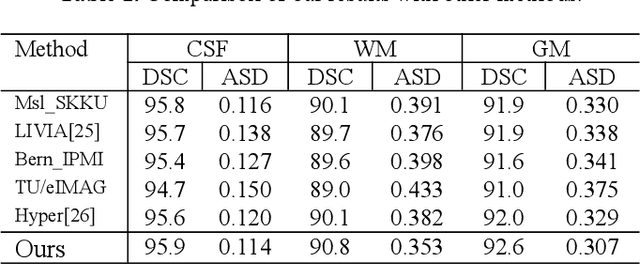
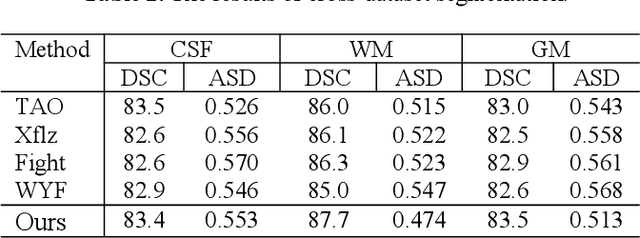

In this paper, we propose a dual aggregation network to adaptively aggregate different information in infant brain MRI segmentation. More precisely, we added two modules based on 3D-UNet to better model information at different levels and locations. The dilated convolution pyramid downsampling module is mainly to solve the problem of loss of spatial information on the downsampling process, and it can effectively save details while reducing the resolution. The self-attention module can integrate the remote dependence on the feature maps in two dimensions of spatial and channel, effectively improving the representation ability and discriminating ability of the model. Our results are compared to the winners of iseg2017's first evaluation, the DICE ratio of WM and GM increased by 0.7%, and CSF is comparable.In the latest evaluation of the iseg-2019 cross-dataset challenge,we achieve the first place in the DICE of WM and GM, and the DICE of CSF is second.
InfiNet: Fully Convolutional Networks for Infant Brain MRI Segmentation
Oct 11, 2018



We present a novel, parameter-efficient and practical fully convolutional neural network architecture, termed InfiNet, aimed at voxel-wise semantic segmentation of infant brain MRI images at iso-intense stage, which can be easily extended for other segmentation tasks involving multi-modalities. InfiNet consists of double encoder arms for T1 and T2 input scans that feed into a joint-decoder arm that terminates in the classification layer. The novelty of InfiNet lies in the manner in which the decoder upsamples lower resolution input feature map(s) from multiple encoder arms. Specifically, the pooled indices computed in the max-pooling layers of each of the encoder blocks are related to the corresponding decoder block to perform non-linear learning-free upsampling. The sparse maps are concatenated with intermediate encoder representations (skip connections) and convolved with trainable filters to produce dense feature maps. InfiNet is trained end-to-end to optimize for the Generalized Dice Loss, which is well-suited for high class imbalance. InfiNet achieves the whole-volume segmentation in under 50 seconds and we demonstrate competitive performance against multiple state-of-the art deep architectures and their multi-modal variants.
* 4 pages, 3 figures, conference, IEEE ISBI, 2018
Exclusive Independent Probability Estimation using Deep 3D Fully Convolutional DenseNets for IsoIntense Infant Brain MRI Segmentation
Sep 27, 2018



The most recent fast and accurate image segmentation methods are built upon fully convolutional deep neural networks. Infant brain MRI tissue segmentation is a complex deep learning task, where the white matter and gray matter of the developing brain at about 6 months of age show similar T1 and T2 relaxation times, having similar intensity values on both T1 and T2-weighted MRIs. In this paper, we propose deep learning strategies to overcome the challenges of isointense infant brain MRI tissue segmentation. We introduce an exclusive multi-label training method to independently segment the mutually exclusive brain tissues with similarity loss function parameters that are balanced based on class prevalence. Using our training technique based on similarity loss functions and patch prediction fusion we decrease the number of parameters in the network, reduce the complexity of the training process focusing the attention on less number of tasks, while mitigating the effects of data imbalance between labels and inaccuracies near patch borders. By taking advantage of these strategies we were able to perform fast image segmentation, using a network with less parameters than many state-of-the-art networks, being image size independent overcoming issues such as 3D vs 2D training and large vs small patch size selection, while achieving the top performance in segmenting brain tissue among all methods in the 2017 iSeg challenge. We present a 3D FC-DenseNet architecture, an exclusive multilabel patchwise training technique with balanced similarity loss functions and a patch prediction fusion strategy that can be used on new classification and segmentation applications with two or more very similar classes. This strategy improves the training process by reducing its complexity while providing a trained model that works for any size input and is fast and more accurate than many state-of-the-art methods.
Isointense infant brain MRI segmentation with a dilated convolutional neural network
Aug 09, 2017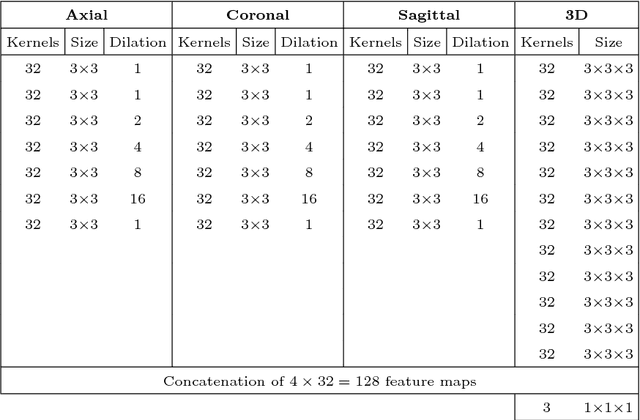


Quantitative analysis of brain MRI at the age of 6 months is difficult because of the limited contrast between white matter and gray matter. In this study, we use a dilated triplanar convolutional neural network in combination with a non-dilated 3D convolutional neural network for the segmentation of white matter, gray matter and cerebrospinal fluid in infant brain MR images, as provided by the MICCAI grand challenge on 6-month infant brain MRI segmentation.
 Add to Chrome
Add to Chrome Add to Firefox
Add to Firefox Add to Edge
Add to Edge